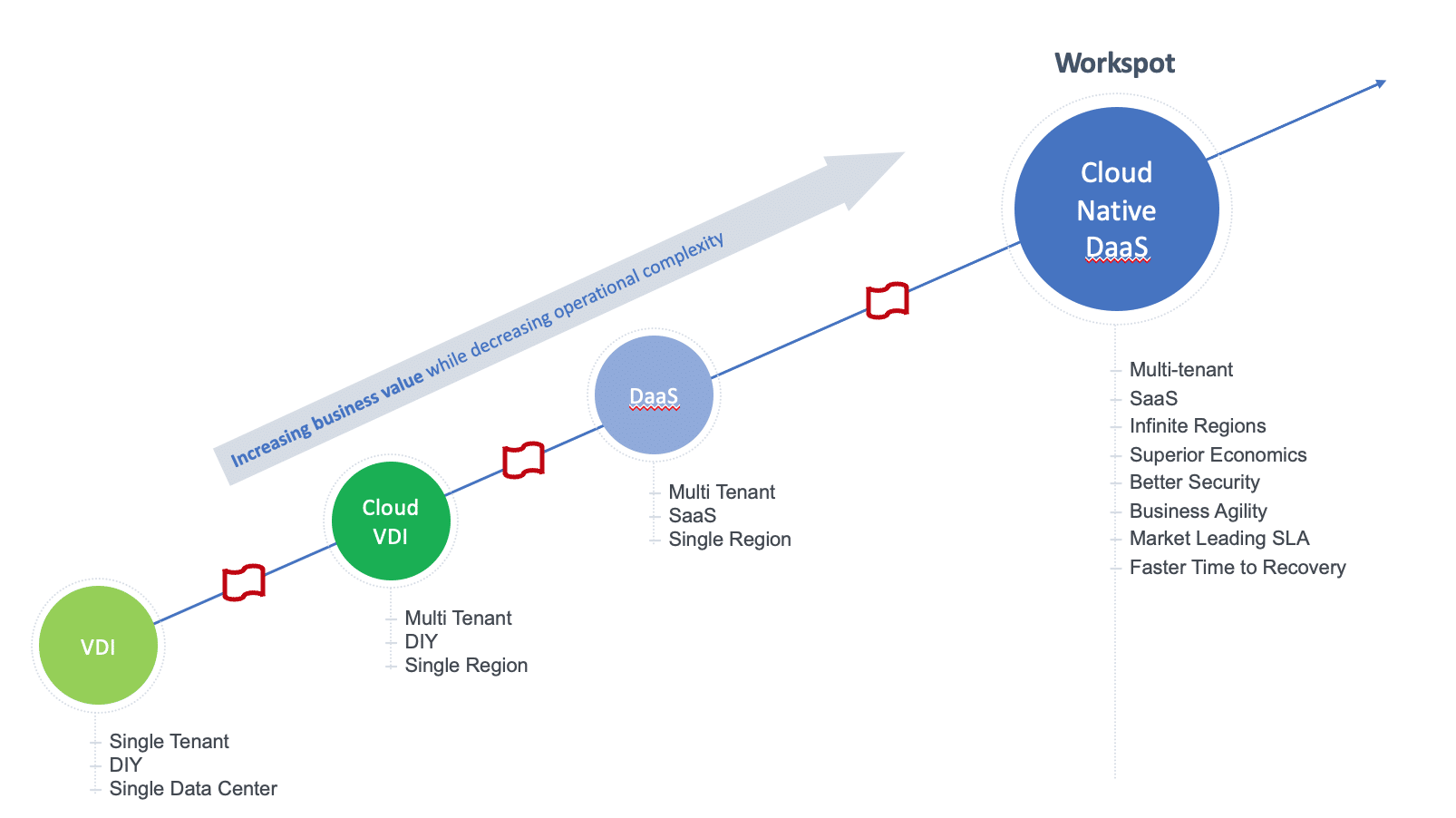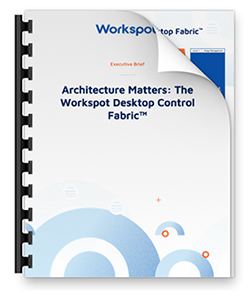If I had to start with the punchline to this blog it would be this: The Workspot Enterprise Desktop Cloud platform delivers increased business value while decreasing operational complexity. What IT team would not want to deliver more value to the business while at the same time dramatically simplifying the technology stack required to do so?
Taking Stock of a Rough Ride
Many IT teams are emerging from this period of unprecedented change and taking stock of how their organizations fared so they can make good decisions about how to move forward. It’s a great time to rethink your current end user computing solution and identify the gaps that came to light over the past year. As you look back, some of the questions you might be asking include:
- Did we have the flexibility needed to instantly provision desktops for end users in a variety of job functions who needed to work remotely?
- Was our company data less secure while people worked from home?
- Did the performance of the remote desktop/virtual desktop solution we used impact productivity?
- Were we able to serve customers as well or better during the pandemic?
- Are we better prepared for a business disruption in the future?
If you’re using a VPN, you might be getting more concerned about security and performance. If you’re using VDI, security is more solid than using a physical PC or a VPN, but there’s more you can do to protect company data. With either solution, it’s likely end users experienced performance problems, which start out being a little annoying, but quickly escalate to frustration and slower output that results in less productivity for the business. And on the other side of all of these challenges are your customers. How well did you serve them?
Now as you look to the future and the best way to modernize end-user computing, there’s little doubt that physical PCs can’t give you the agility you need. So as you evaluate or revisit virtual desktops, you must consider the following two key questions:
- Do we have the tools, people and processes in place to manage the cost of our virtual desktops?
- Do we have the tools, people and processes in place to ensure reliability that meets or exceeds 99.95%, plus deliver amazing performance to our users so they are productive anywhere?
These questions will determine if your organization has an appetite for a do-it-yourself (DIY) approach to virtual desktops where your IT team is responsible for everything – architecting, provisioning, managing, updating, and troubleshooting all of the infrastructure. If the answer is no, read on!
There’s No Shortcut to Cloud-Native DaaS
The approaches to virtual desktops have significant differences. On-premises VDI and its sibling, Cloud VDI, are by nature single tenant solutions, limited by their architectures. I don’t mean to say that this is bad, it just is. If your organization is distributed across the globe, a single tenant solution will be troublesome for both IT teams and end users. To deliver great performance, you would need your on-prem solution to be replicated in multiple data centers. The same is true for Cloud VDI – you need to replicate the entire VDI stack in multiple cloud regions so virtual desktops are closer to your end users and latency is therefore reduced. The problem is that all that replicating is complicated, expensive and almost impossible to manage. You might consider Desktop-as-a-Service in the cloud. A Managed Service Provider could do it for you, but they will be using someone else’s single-tenant solution, so the single tenant issues don’t go away, and you lose more control. That leaves a multi-tenant cloud DaaS solution; there are two for you to consider. One of the two is multi-tenant, but only runs on a single public cloud. The second one is Workspot.
Workspot is the only cloud-native SaaS platform that delivers cloud desktops as a service across infinite public cloud regions.
The road from on-premises VDI to cloud-VDI and then to Desktop-as-a-Service (DaaS) is not a well-paved highway. One approach does not evolve into another – Cloud VDI as it exists today is not cloud-native, and it will never evolve into a modern, cloud-native architecture. That has security, performance and scalability consequences for your implementation. If you look at the history of SaaS companies, they don’t evolve – they are created from scratch. Salesforce did not evolve from an earlier instantiation of a CRM system. It was designed from the beginning as a massively scalable SaaS solution for CRM. Workspot was designed from the beginning as a massively scalable SaaS cloud platform for delivering virtual desktops.
The Modern Way to Work
Today, organizations need to be agile. It’s such an overused word, but if you were a Workspot customer in March 2020, the tangible result of the agility we bring is that you had your employees home and working within hours. Going forward, you can spin-up 10s, 100s or 1000s of cloud desktops in a few minutes – in multiple cloud regions around the world as new opportunities arise or you have new M&A activity. Your TCO is lower, your overall security posture is strengthened by our 24×7 real-time global activity monitoring, and in the event of a business disruption, your time-to-recovery just became minutes instead of days. All of these capabilities are powered by the Workspot Desktop Control Architecture™ built from the ground up – like all great SaaS companies!
Ready to see how it works? Schedule a demo now!
Read the Executive Brief for more details about the Workspot difference.






